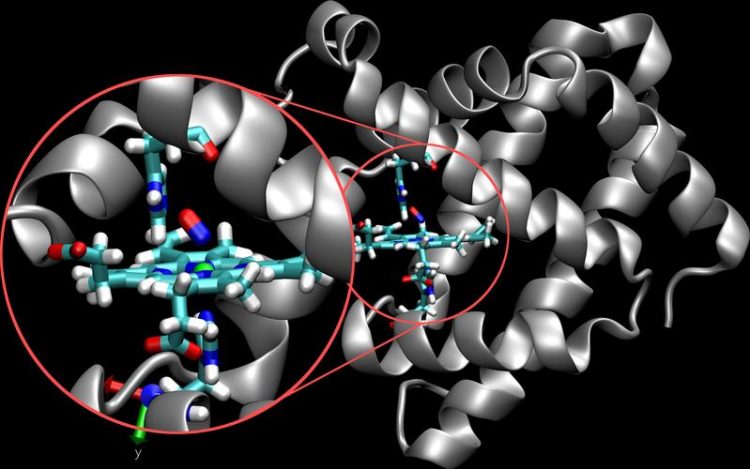Computer Simulation Renders Transient Chemical Structures Visible

Structure of the protein myoglobin (silver) with the embedded active site (in color). In this image, the nitrogen molecule (red/blue) is bonded to the iron atom (green ball). University of Basel / Department of Chemistry
Using computational chemistry, it is possible to characterize the motion of individual atoms of a molecule. Today, the latest simulation techniques allow scientists to quantitatively describe the dynamics of molecules and systems containing hundreds of thousands of atoms.
These techniques are important, above all, for characterizing molecular states that are difficult to observe directly in experiments due to their short lifetime. Here, computer simulations are a source of valuable complementary insight.
A protein’s function is determined by its structure and dynamics. It is particularly important that information relevant to the nature of structures and molecular processes in the active site – i.e. the place where chemical reactions take place – is known. The formation and breaking of chemical bonds is a dynamic process that results in structural changes.
The observable dynamics usually result in stable (low energy) states that are reached via one or more metastable (higher energy) intermediate steps. Whether a metastable state can be detected directly in an experiment depends on its lifetime. If it is too short, only indirect detection methods are available.
Computer determines atomic geometry
Now, a research team led by Prof. Markus Meuwly from the Department of Chemistry at the University of Basel has used molecular dynamics simulations to characterize the spatial and temporal behavior of the protein myoglobin.
Myoglobin plays an important role in the transport of oxygen within cells and is found mainly in muscle tissue. Nitrogen monoxide, which is formed in the cells, is a short-lived and reactive messenger that is important in regulating vasodilation under hypoxia.
“The process by which nitrogen monoxide binds to myoglobin is already well characterized experimentally, which is important for the calibration of computer simulations,” explains Meuwly. “There is also experimental evidence for the existence of metastable intermediates, but our simulations provide insights into the underlying chemical structure and the dynamics of these intermediates, and thus the function of the protein.
Together with experimental observations, therefore, computer simulations are the basis for an understanding of complex chemical and biological systems. Accordingly, this combined approach also provides a starting point for further questions to be addressed; for example, the adaptation and optimization of proteins or active pharmaceutical agents. This requires an understanding of the underlying processes at the molecular and atomic level.
Original source
Maksym Soloviov, Akshaya K. Das, Markus Meuwly
Structural Interpretation of Metastable States in MbNO
Angew. Chem. Int. Ed. (2016), doi: 10.1002/ange.201604552
Further information
Prof. Dr. Markus Meuwly, University of Basel, Department of Chemistry, Tel. +41 61 267 38 21, email: m.meuwly@unibas.ch
Media Contact
More Information:
http://www.unibas.chAll latest news from the category: Life Sciences and Chemistry
Articles and reports from the Life Sciences and chemistry area deal with applied and basic research into modern biology, chemistry and human medicine.
Valuable information can be found on a range of life sciences fields including bacteriology, biochemistry, bionics, bioinformatics, biophysics, biotechnology, genetics, geobotany, human biology, marine biology, microbiology, molecular biology, cellular biology, zoology, bioinorganic chemistry, microchemistry and environmental chemistry.
Newest articles

High-energy-density aqueous battery based on halogen multi-electron transfer
Traditional non-aqueous lithium-ion batteries have a high energy density, but their safety is compromised due to the flammable organic electrolytes they utilize. Aqueous batteries use water as the solvent for…

First-ever combined heart pump and pig kidney transplant
…gives new hope to patient with terminal illness. Surgeons at NYU Langone Health performed the first-ever combined mechanical heart pump and gene-edited pig kidney transplant surgery in a 54-year-old woman…

Biophysics: Testing how well biomarkers work
LMU researchers have developed a method to determine how reliably target proteins can be labeled using super-resolution fluorescence microscopy. Modern microscopy techniques make it possible to examine the inner workings…





















